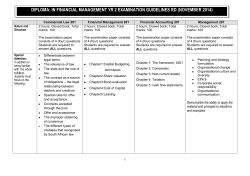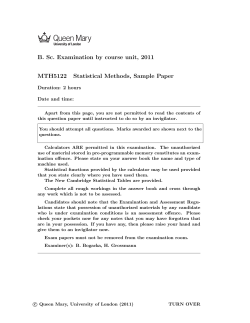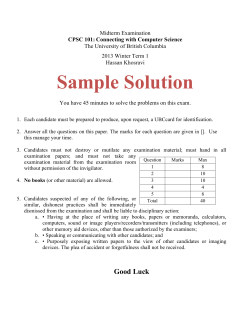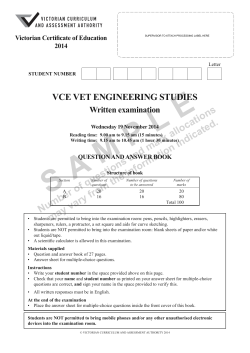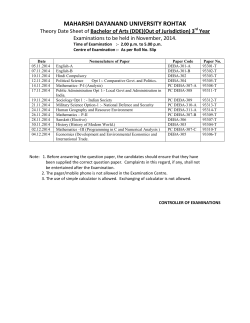
View Sample - MADE EASY Publications
UPPSC Uttar Pradesh Public Service Commission Combined State Engineering Services Examination Civil Engineering Previous Years Solved Papers Objective Paper-I Objective Paper-II General Hindi 2015 www.madeeasypublications.org Volume 1 General Studies MADE EASY Publications Corporate Office: 44-A/4, Kalu Sarai (Near Hauz Khas Metro Station), New Delhi-110016 E-mail: infomep@madeeasy.in Contact: 011-45124612, 0-9958995830, 8860378007 Visit us at: www.madeeasypublications.org UPPSC-Combined State Engineering Services Examination Civil Engineering : Volume-1 Copyright © 2015, by MADE EASY Publications. All rights are reserved. No part of this publication may be reproduced, stored in or introduced into a retrieval system, or transmitted in any form or by any means (electronic, mechanical, photo-copying, recording or otherwise), without the prior written permission of the above mentioned publisher of this book. First Edition: 2015 ISBN: 978-93-83643-66-0 © All rights reserved by MADE EASY PUBLICATIONS. No part of this book may be reproduced or utilized in any form without the written permission from the publisher. Preface Combined State Engineering Services has been always preferred by Engineers due to job stability and opportunity to work in home sate. UPPSC Combined State Engineering Services examination is conducted time to time but not every year. MADE EASY team has made deep study of previous exam papers and observed that a good percentage of questions are of repetitive in nature, therefore previous year’s papers are advisable to solve before a candidate takes the exam. This book is also useful for MP State Engineering Services, UPSC Engineering Services and other Competitive exams for Engineering graduates. The first edition of this book is prepared with due care to provide complete solutions to all questions with accuracy. I would like to give credit of Publishing this book to Mr, Sujeet Kumar, who has been MADE EASY Student and is selected for UPSC engineering services 2013 (IRSE). He put hard efforts in collecting & Solving Previous years UPPCS Papers. I have true desire to serve student community by providing good source of study and quality guidance. I hope this book will be proved an important tool to succeed in UPPSC and other competitive exams. Any suggestions from the readers for improvement of this book are most welcome. With Best Wishes B. Singh CMD, MADE EASY About Exam Combined State Engineering Service Examination is a competitive exam conducted by Uttar Pradesh Public Service Commission (UPPSC) to recruit State Government’s Gazetted Officials (Class-II) for various engineering organizations. These officials are responsible for the technical and managerial functions of those departments. The services offered under this examination are considered as most prestigious Civil Services in society. At entry level, a young probationary officer is appointed as sub-divisional officer. The exam is conducted by Uttar Pradesh Public Commission in the month of March/April in alternate years or when vacancies are available. Written examination is conducted at various centre in Allahabad and Lucknow only. The notification of the examination is updated in the UPPSC calendar and is available on their websites www.uppsc.up.nic.in and www.uppsc.org.in. Written examination comprises of objective as well as conventional papers. General Hindi and General Studies is a part of general assessment, apart from Civil Engineering subjects. The entire Civil Engineering is divided into two parts. Two papers; one objective and one conventional are asked from syllabus covered under each part. Written examination continues for 3 days, first day is allocated for General Hindi (Ist inning) and General Studies (IInd inning). The second day is allocated for objective papers I and II. Third or final day is allocated for conventional Paper-I and Paper-II. The duration of all objective papers is of 2 hours, whereas the conventional paper is of 3 hours. The conventional answer sheet of a candidate are evaluated only once he qualifies in the objective examination. The candidate who qualify the written exam are called for interview. nnnn Combined State Engineering Service Examination 2011 Apendix-1 Part-1 (Objective Paper) A. General Ability 1. General Hindi 2. General Studies Civil Engineering Subject B. 50 marks 100 marks 2 Hrs. 2 Hrs. 1. Question Paper-1 100 marks 2 Hrs. 2. Question Paper-2 100 marks 2 Hrs. Total 350 Marks Part-2 (Conventional Paper) C. Civil Engineering Subject 1. Engineering -1 200 marks 3 Hrs. 2. Engineering -2 200 marks 3 Hrs. D. Total 400 Marks Interview 100 Marks Grand Total 850 marks No. of Vacancies S. No. 2. 3. 4. 5. General Recruitment 1. 6. 7. Special Rect. Total Vacancies SC of UP ST of UP OBC of UP General Branch Asstt. Engg. 640 134 13 173 320 Civil Minor Irrigation Deptt.t Astt. Engg. 10 02 — 03 05 Civil Rural Engg. Service Deptt. Astt. Engg. 24 05 — 12 07 Civil Land Development and Bhumi Sanarakshan — — — 05 Water Resource Deptt. Adhikari/Technical 08 Civil/ Agriculture Name of Department Name of Post Irrigation Deptt. Officer Public Works Deptt. (PWD) Astt. Engg. 140 — 03 03 114 Civil Ground Water Deptt. Astt. Engg. 06 — — 23 06 Civil Irrigation Deptt. Astt. Engg. 17 Pay Scale: Rs. 15600/- Rs. 39100/- (Grade pay Rs. 5400/- Post class-II Gazetted). Only PH Civil Syllabus Paper-1 (Part A) Note: Answer any five questions, at least two from each part. Theory of Structure : Principles of superposition; reciprocal theorem, unsymmetrical bending. Determinate and indeterminate structure, simple and space frames; degree of freedom; virtual work; energy theorem; deflection of trusses; redundant frames, three moment equation; slope deflection and moment distribution methods; column analogy; energy methods; approximate and numerical methods. Moving loads-sharing force and bending moment diagrams; influence lines for simple and continuous beams. Analysis of determinate and indeterminate arches. Matrix methods of analysis, stiffness and flexibility matrices. Steel Design : Factors of safety and load factor; design of tension; compression and flexural members; built-up beams and plate girders, semi-rigid and rigid connections, design of stanchions, slab and gusseted bases; cranes and gantry girders; roof trusses; industrial and multi-storied buildings, plastic design of frames and portals. R.C.C Design : Design of slabs, simple and continuous beams columns, footing-single and combined, raft foundation; elevated water tanks, encased beams and column, ultimate load design. Methods and systems of prestressing, losses in prestress. Paper-2 (Part A) Note: Answer any five questions, at least two from each part. (A) Building Construction : Building materials and construction- timber, stonebrick, sand, surkhi, mortar, concrete, paints and varnishes, plastics etc. Detailing of walls, floors roofs, ceilings, stair cases, door and windows. Finishing of building: Plastering, pointing, etc. use of building codes. Ventilation, air conditioning, lighting and acoustics. Building estimates and specifications, construction, scheduling. PERT and CPM methods. (B) Railways and Highways Engineering : Railway-permanent way, ballast, sleeper; chair and fastening; point and crossing, different type of turn out, cross over, setting out of points. Maintenance of track, superelevation, creep of rail, ruling gradients; track resistance, tractive effect, curve resistance, station yards, station buildings, platform sidings, turn tables. Signals and interlocking; level crossing. Road and Runways : Classification of roads, planning, geometric design, design of flexible and rigid pavement; subbases and wearing surfaces. Traffic engineering and traffic surveys; intersection, road sign; signals and marking. (C) Surveying : Plane table surveying; equipment and methods; solution of two and three point problems. Errors and precautions. Triangulation; base line and it’s measurement, satellite station; intervisibility of station; error and least squares, general methods of least square, estimation with inter disciplinary approach, adjustment of levels nets and triangulation nets. Matrix notation solutions. Layout of curves; simple, compound, reverse, transition and vertical curves. Project surveys and layout of civil engineering works such as buildings, bridges, tunnels and hydroelectric projects. nnnn Contents Civil Engineering : Volume-I Section-A : Objective Paper-I Section-C : General Hindi 1. Structural Analysis...................................................1-38 1. 2011 Solved Paper Hindi................................329-341 2. Design of Concrete Structure........................... 39-59 2. 2008 Solved Paper Hindi................................342-352 3. Design of Steel Structure.................................... 60-78 3. 2007 Solved Paper Hindi................................353-363 4. Fluid Mechanics...................................................79-100 4. 2007 (II) Solved Paper Hindi..........................364-372 5. Irrigation Engineering.....................................101-108 5. 2004 Solved Paper Hindi................................373-381 6. Soil Mechanics....................................................109-139 Actual Paper held in 2011 (Objective-I)........140-149 Model Test -I . ......................................................382-388 Model Test -II . .....................................................389-395 Model Test-I (Obj. Paper-I)................................150-167 Model Test-II (Obj. Paper-I)...............................168-185 Section-B : Objective Paper-II Section-D : General Studies 1. General Science.................................................397-308 2. General Studies..................................................409-419 1. Building Materials.............................................187-191 3. Geography...........................................................420-433 2. Building Construction.....................................192-196 4. Polity......................................................................434-443 3. Construction Management & Planning....197-200 5. Economy...............................................................444-447 4. Engineering Hydrology...................................201-210 6. G.K. Current & Miscellaneous......................448--457 5. Irrigation Engineering.....................................211-231 6. Transportation Engineering..........................232-252 7. Environmental Engineering..........................253-269 8. Surveying.............................................................270-289 Actual Paper held in 2011 (Objective-II).......290-297 Model Test-I (Obj. Paper-I)................................298-312 Model Test-II (Obj. Paper-I)...............................313-327 Actual Paper held in 2011 (GS).......................458-465 Model Test -I . ......................................................466-474 Model Test -II . .....................................................475-483 nnnn
© Copyright 2025

